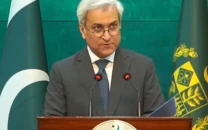Provincial budgets: exceeding expectations
Budgets for all four provinces are out and it seems that they have done a much better job than the federal government

Representational image. PHOTO: REUTERS
Khyber-Pakhtunkhwa (K-P) has allocated Rs124 billion for the health sector — a massive 43% increase over last year. Balochistan and Sindh also increased their health sector budget by 32 and 16% respectively. Punjab, however, only offered a modest increase of less than 2%, yet reaching a massive Rs284 billion allocation.
Relief and stimulus measures also dominated provincial budgets, with Punjab offering an unprecedented Rs56 billion tax relief and a sizeable Rs30 billion public works programme to generate employment. K-P reduced sales tax on 27 categories of services to stimulate economic activities while Sindh introduced a social protection and economic sustainability package of Rs34 billion. Balochistan, however, lagged behind with only Rs680 million tax relief and a Rs3 billion relief package. Given the scale of the pandemic, these measures may not be enough but do show budget responsiveness to citizens’ needs.
Despite an unprecedented fiscal crunch, Punjab, K-P and Balochistan all seem to have prioritised development spending. They put their foot down on any increase in pension and salaries. Punjab re-calibrated its entire foreign-funded portfolio, speeding up investments, resulting in a record 120% year-on-year increase while K-P went for belt-tightening, improved budgeting and recruitment efficiencies to create fiscal space.
As a result, both Punjab and K-P were able to protect their development spending much closer to last year’s allocations and much higher than what they actually spent. Balochistan went even further and increased its development budget by 24%, but this came with an overall budget deficit of Rs87 billion. In comparison, Punjab posted a surplus of Rs125 billion while K-P presented a balanced budget.
Sindh on the other hand offered a 10% increase in government salaries but had to accommodate a 23% reduction in development allocation, besides an unfunded budget deficit of Rs18 billion.
Most importantly, it seems that the fiscal crunch has created a newfound appetite for reform in the provinces. K-P has embarked on reforming its tax regime with elimination of redundant taxes and integrating duplicate taxes. Property tax rates have been rationalised with rebates being offered to improve compliance. For tourism sector, tax hypothecation has been introduced, ring-fencing tax collection for betterment of tourist areas. The K-P budget has also touched upon the issue of ballooning government size and growing salary and pension bill, highlighting underlying fiscal challenges. Punjab finally announced operationalisation of the long-promised South Punjab Secretariat. The province also strengthened its public private partnerships (PPP) regime, with a five-year sales tax exemption for PPP projects.
But notwithstanding these promising measures, the provinces face a host of challenges. Increased development spending remains contingent on federal transfers, donor assistance and financing the budget deficit (in case of two provinces). Any slippage could easily squeeze the development budgets. This calls for transparent sub-provincial resource distribution to avoid elite capture of these meagre resources through special district-specific packages.
Moreover, going forward, mobilising private investment would be the key to supplement the public investment through PPPs. This is where Sindh is far ahead in the game. Punjab is still struggling to revamp its PPP regime whereas K-P is in the process of revising its PPP law altogether. These efforts need to be prioritised.
Lastly, the generous tax relief measures should be linked with widening the tax net (tax incentives linked with registration, etc) rather than mere blanket tax holidays so that tax concessions of today could lead to revenues of tomorrow.
Published in The Express Tribune, June 23rd, 2020.
Like Opinion & Editorial on Facebook, follow @ETOpEd on Twitter to receive all updates on all our daily pieces.














COMMENTS
Comments are moderated and generally will be posted if they are on-topic and not abusive.
For more information, please see our Comments FAQ